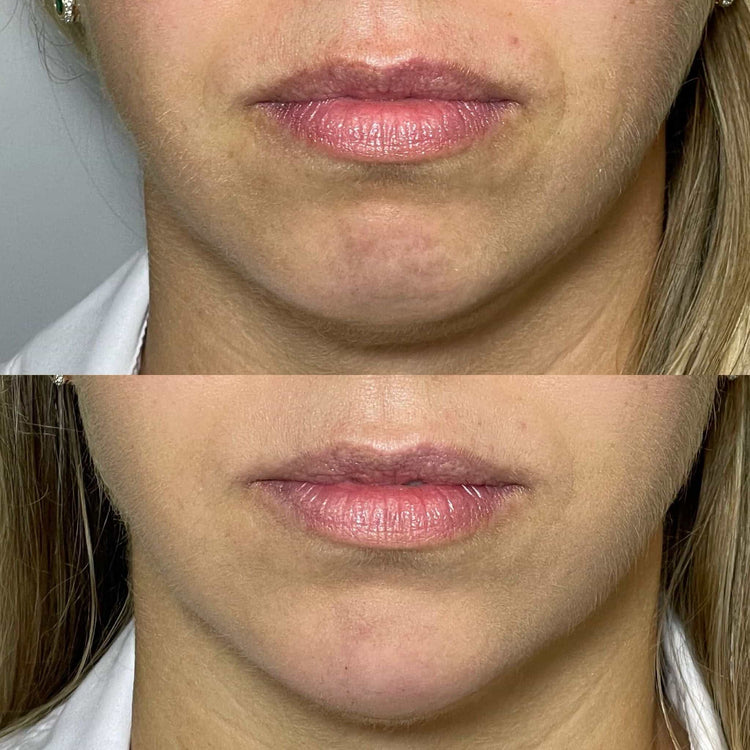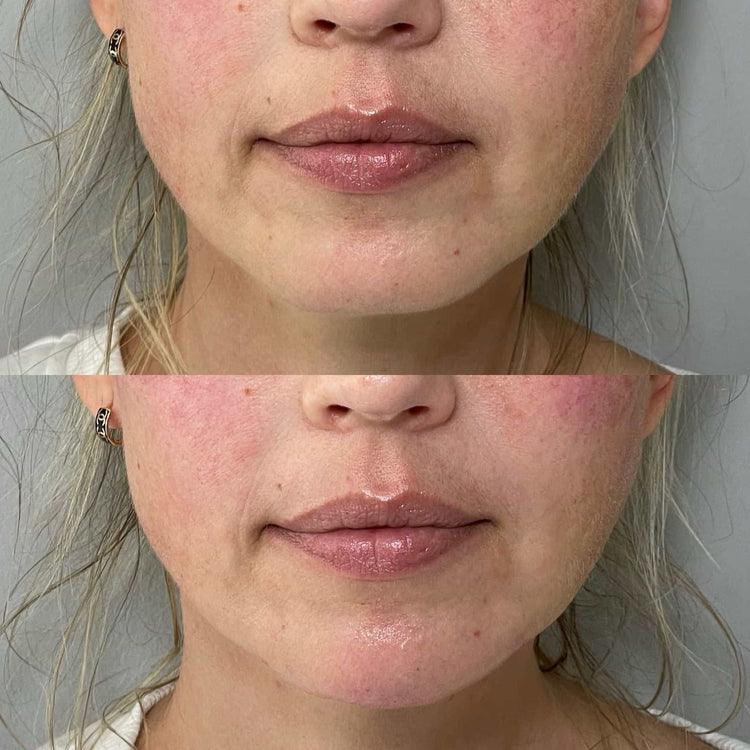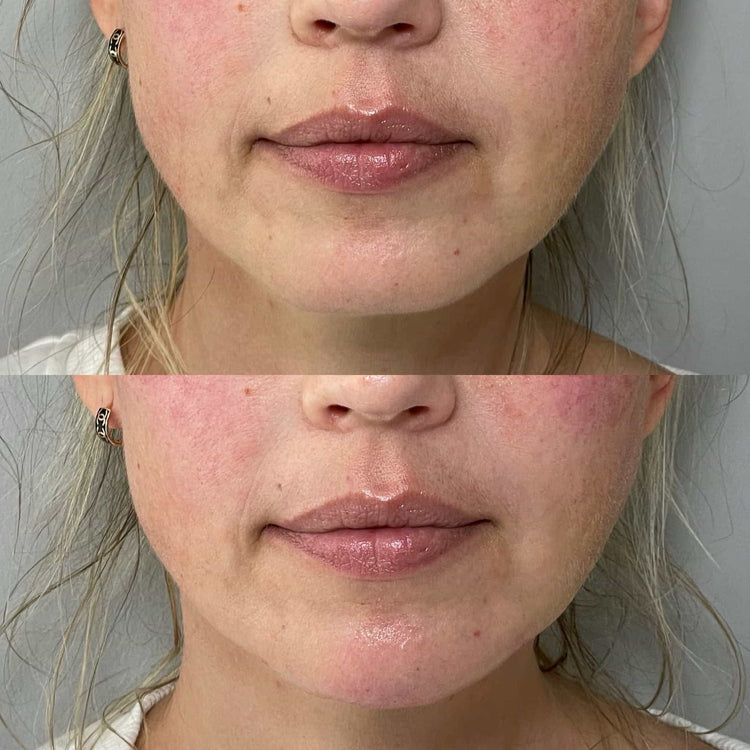What Are Chin Fillers?
A well-defined chin plays a crucial role in facial harmony, contributing to overall balance and definition. As we age, the chin can lose its prominence due to fat loss, muscle weakening, or bone structure changes. Chin fillers offer a non-surgical solution to restore a youthful chin contour and enhance facial aesthetics.
Types of Fillers
A well-defined chin plays a crucial role in facial harmony, contributing to overall balance and definition. As we age, the chin can lose its prominence due to fat loss, muscle weakening, or bone structure changes. Chin fillers offer a non-surgical solution to restore a youthful chin contour and enhance facial aesthetics.
There are various types of dermal fillers used for chin augmentation:

- Hyaluronic acid (HA) fillers: These are the most common type of chin filler. HA is a naturally occurring substance in the body that attracts and retains water, giving it a plumping effect. HA fillers are temporary, typically lasting 6-18 months.
- Calcium hydroxylapatite (CaHA): This type of filler provides longer-lasting results than HA fillers, often lasting up to 18 months or more. It is also known for its ability to stimulate collagen production.
- Poly-L-lactic acid (PLLA): This filler stimulates the body’s own collagen production, gradually increasing chin volume over several weeks or months. Results with PLLA are typically long-lasting, lasting 1-2 years or more.
How They Work
Chin fillers are injectable substances used to enhance the shape and projection of the chin. They work by adding volume beneath the skin, creating a more defined and contoured appearance.
Different types of dermal fillers are suitable for chin augmentation. Hyaluronic acid (HA) fillers, which are water-attracting substances naturally found in the body, provide temporary results that typically last 6 to 18 months. Calcium hydroxylapatite (CaHA) fillers offer longer-lasting effects, often up to 18 months or more, and also stimulate collagen production for added volume enhancement. Poly-L-lactic acid (PLLA) fillers work by triggering the body’s own collagen production, gradually increasing chin volume over time. The results with PLLA are typically long-lasting, lasting 1 to 2 years or more.
Benefits of Chin Fillers for Contouring
Chin fillers offer a non-surgical approach to restoring a youthful and well-defined chin contour. They work by adding volume beneath the skin, creating a smoother transition between the chin and jawline, and enhancing overall facial balance.
Improved Facial Symmetry
Chin fillers are an effective way to achieve a more balanced and defined facial profile. By strategically injecting these substances into the chin area, they can help restore lost volume and create a stronger, more prominent chin shape. This can dramatically improve facial symmetry, making features appear more aligned and harmonious.
Furthermore, chin fillers can enhance the appearance of other facial features by creating a better overall contour. A well-defined chin can accentuate the jawline, make lips look fuller, and create a more youthful appearance by improving the balance between the lower face and forehead.
Enhanced Jawline Definition
Chin fillers provide numerous benefits for contouring and enhancing jawline definition. By adding volume to the chin area, they create a smoother transition between the chin and jawline, resulting in a more balanced and defined facial profile.
This augmentation can also improve facial symmetry by making features appear more aligned and harmonious. A well-defined chin can accentuate the jawline, creating a more prominent and sculpted appearance.
Additionally, chin fillers can enhance the appearance of other facial features by improving overall contour. A stronger chin can make lips look fuller and contribute to a more youthful appearance by balancing the lower face with the forehead.
Minimized Appearance of Wrinkles and Sagging Skin
Chin fillers offer a range of benefits for individuals seeking to restore a youthful chin contour and enhance their facial aesthetics. By strategically injecting these substances beneath the skin, they effectively add volume to the chin area, creating a smoother transition between the chin and jawline.
This augmentation can significantly improve facial symmetry by making features appear more aligned and harmonious. A well-defined chin accentuates the jawline, resulting in a more prominent and sculpted appearance. Furthermore, chin fillers contribute to a more youthful look by balancing the lower face with the forehead, enhancing lip fullness, and creating a smoother overall contour.
In addition to their cosmetic benefits, chin fillers can help minimize the appearance of wrinkles and sagging skin around the chin area. By adding volume and plumping the skin, they can effectively reduce the visibility of fine lines and wrinkles, resulting in a smoother, more youthful complexion.
The Procedure
A well-defined chin is essential for facial harmony and balance. As we age, changes in fat distribution, muscle tone, and bone structure can cause the chin to lose its definition. Chin fillers offer a non-surgical solution to address this issue, restoring a youthful contour and enhancing overall facial aesthetics.
Consultation
Chin fillers are injectable substances designed to enhance the shape and projection of the chin. These fillers work by adding volume beneath the skin, creating a smoother transition between the chin and jawline and resulting in a more defined appearance.
Different types of dermal fillers are suitable for chin augmentation, each with its own properties and longevity. Hyaluronic acid (HA) fillers are popular due to their temporary nature, lasting approximately 6 to 18 months. Calcium hydroxylapatite (CaHA) fillers provide longer-lasting results, often extending up to 18 months or more, and have the added benefit of stimulating collagen production.
Poly-L-lactic acid (PLLA) fillers work by triggering the body’s own collagen production, gradually increasing chin volume over time. Results with PLLA tend to be long-lasting, often lasting 1 to 2 years or more.
Injection Process
Chin fillers are injectable substances used to enhance the shape and projection of the chin. They work by adding volume beneath the skin, creating a more defined and contoured appearance.
The injection process typically involves numbing the area with a local anesthetic. A small needle is then used to inject the filler into specific points along the chin, carefully sculpting the desired shape. The procedure itself is relatively quick and minimally invasive, often taking only 30 minutes to an hour to complete.
Following the injection, there may be some mild bruising or swelling, which typically subsides within a few days. Patients can usually return to their normal activities immediately after the treatment.
Recovery Time
Recovery time after a chin filler procedure is generally minimal. Most patients experience only mild side effects, such as bruising and swelling, which typically subside within a few days.
You should be able to resume your normal activities immediately following the treatment.
Potential Risks and Side Effects
While chin fillers offer numerous benefits for enhancing facial aesthetics, it’s essential to be aware of potential risks and side effects. As with any medical procedure, there are potential complications that can arise. These may include infection, allergic reactions, asymmetry, lumps or bumps, and changes in skin texture.
Infection
Potential risks associated with chin fillers include infection, which can occur if the injection site becomes contaminated.
Allergic reactions to the filler material are also possible, ranging from mild itching or redness to more severe anaphylactic reactions in rare cases.

Asymmetry can occur if the filler is not evenly distributed during the injection process, resulting in an uneven chin contour.
Lumps or bumps may form at the injection site due to improper placement of the filler.
Changes in skin texture, such as thickening or hardening, can also occur in some cases.
Allergic Reactions

Potential risks associated with chin fillers include infection, which can occur if the injection site becomes contaminated. Allergic reactions to the filler material are also possible, ranging from mild itching or redness to more severe anaphylactic reactions in rare cases. Asymmetry can occur if the filler is not evenly distributed during the injection process, resulting in an uneven chin contour. Lumps or bumps may form at the injection site due to improper placement of the filler. Changes in skin texture, such as thickening or hardening, can also occur in some cases.
Lumps and Nodules
While chin fillers offer numerous benefits for enhancing facial aesthetics, it’s essential to be aware of potential risks and side effects. As with any medical procedure, there are potential complications that can arise. These may include infection, allergic reactions, asymmetry, lumps or bumps, and changes in skin texture.
Potential risks associated with chin fillers include infection, which can occur if the injection site becomes contaminated. Allergic reactions to the filler material are also possible, ranging from mild itching or redness to more severe anaphylactic reactions in rare cases. Asymmetry can occur if the filler is not evenly distributed during the injection process, resulting in an uneven chin contour. Lumps or bumps may form at the injection site due to improper placement of the filler.
Changes in skin texture, such as thickening or hardening, can also occur in some cases.
Choosing a Qualified Practitioner
Choosing a qualified practitioner is paramount when considering cosmetic procedures like chin fillers.
Credentials and Experience
Choosing a qualified practitioner is essential for achieving optimal results and minimizing potential risks associated with chin filler treatments. Look for a board-certified dermatologist, plastic surgeon, or licensed esthetician who specializes in facial injectables.
Credentials and experience are crucial when selecting a provider. Ensure that the practitioner has appropriate certifications and licenses to perform injections in your state. Inquire about their experience with chin fillers and review before-and-after photos of previous patients to assess their skill level and aesthetic approach.
Don’t hesitate to ask questions about the types of fillers they use, their injection techniques, and potential risks and side effects. It’s important to feel comfortable and confident in your practitioner’s expertise before undergoing any procedure.
Before-and-After Photos
Choosing a qualified practitioner is essential for achieving optimal results and minimizing potential risks associated with chin filler treatments. Look for a board-certified dermatologist, plastic surgeon, or licensed esthetician who specializes in facial injectables.
Credentials and experience are crucial when selecting a provider. Ensure that the practitioner has appropriate certifications and licenses to perform injections in your state. Inquire about their experience with chin fillers and review before-and-after photos of previous patients to assess their skill level and aesthetic approach.
Before-and-after photos can provide valuable insight into a practitioner’s aesthetic philosophy and technical skill. They allow you to visualize the types of results that are achievable and determine if the practitioner’s style aligns with your desired outcome.
Don’t hesitate to ask questions about the types of fillers they use, their injection techniques, and potential risks and side effects. It’s important to feel comfortable and confident in your practitioner’s expertise before undergoing any procedure.
Consultation Process
Choosing a qualified practitioner is essential for achieving optimal results and minimizing potential risks associated with chin filler treatments. Look for a board-certified dermatologist, plastic surgeon, or licensed esthetician who specializes in facial injectables. Credentials and experience are crucial when selecting a provider. Ensure that the practitioner has appropriate certifications and licenses to perform injections in your state. Inquire about their experience with chin fillers and review before-and-after photos of previous patients to assess their skill level and aesthetic approach.
Don’t hesitate to ask questions about the types of fillers they use, their injection techniques, and potential risks and side effects. It’s important to feel comfortable and confident in your practitioner’s expertise before undergoing any procedure.
The consultation process typically involves an initial discussion with the practitioner where you will discuss your aesthetic goals, medical history, and any concerns or questions you may have.
The practitioner will examine your chin area, assess your facial structure, and recommend suitable filler types and treatment options based on your individual needs. They will also explain the procedure in detail, including potential risks and side effects, and answer any further questions you may have.
Long-Term Results and Maintenance
Long-term results with chin fillers vary depending on the type of filler used. Hyaluronic acid fillers typically last 6 to 18 months, while calcium hydroxylapatite (CaHA) fillers can provide results for up to 18 months or longer. Poly-L-lactic acid (PLLA) fillers stimulate collagen production, leading to more long-lasting results that often extend 1 to 2 years or more.
To maintain the desired results after chin filler treatment, it’s important to follow your practitioner’s instructions for post-treatment care. This may include avoiding strenuous activity, sun exposure, and certain skincare products for a specific period. Regular touch-up appointments will be necessary to replenish the filler and maintain the desired volume as it gradually diminishes over time. The frequency of touch-up appointments will depend on the type of filler used and individual patient factors.
- Can Fillers Restore A Youthful Chin Contour - May 6, 2025
- Downturned Smile Treatment Near Ockley, Surrey - May 5, 2025
- How To Fix Turkey Neck? - May 5, 2025
